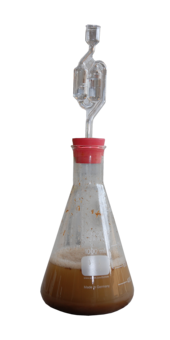User:Eaberry/sandbox
| Original author(s) | Leslie Lamport |
|---|---|
| Platform | Cross-platform |
| Type | Typesetting |
| License | LaTeX Project Public License (LPPL) |
| Website | www.latex-project.org |
LaTeX (formatted as LaTeX, pronounced /ˈlɑːtɛx/, /ˈlɑːtɛk/, /ˈleɪtɛx/, or /ˈleɪtɛk/), is a document markup language and document preparation system for the TeX typesetting program. The term LaTeX refers only to the language in which documents are written, not to the editor application used to write those documents. In order to create a document in LaTeX, a .tex file must be created using some form of text editor. While most text editors can be used to create a LaTeX document, a number of editors have been created specifically for working with LaTeX.
LaTeX is widely used in academia.[1][2] It is also used as the primary method of displaying formulas on Wikipedia. As a primary or intermediate format, e.g., translating DocBook and other XML-based formats to PDF, LaTeX is used because of the high quality of typesetting achievable by TeX. The typesetting system offers programmable desktop publishing features and extensive facilities for automating most aspects of typesetting and desktop publishing, including numbering and cross-referencing, tables and figures, page layout and bibliographies.
LaTeX is intended to provide a high-level language that accesses the power of TeX. LaTeX essentially comprises a collection of TeX macros and a program to process LaTeX documents. Because the TeX formatting commands are very low-level, it is usually much simpler for end-users to use LaTeX.
LaTeX was originally written in the early 1980s by Leslie Lamport at SRI International.[3] The current version is LaTeX2e (styled as LaTeX2ε). LaTeX is free software and is distributed under the LaTeX Project Public License (LPPL).Template:MaTeX2e
Typesetting system
LaTeX is based on the philosophy that authors should be able to focus on the content of what they are writing without being distracted by its visual presentation. In preparing a LaTeX document, the author specifies the logical structure using familiar concepts such as chapter, section, table, figure, etc., and lets the LaTeX system worry about the presentation of these structures. It therefore encourages the separation of layout from content while still allowing manual typesetting adjustments where needed. This is similar to the mechanism by which many word processors allow styles to be defined globally for an entire document or the use of Cascading Style Sheets to style HTML.
Biochemical process of fermentation of sucrose

The chemical equations below summarize the fermentation of sucrose (C12H22O11) into ethanol (C2H5OH). Alcoholic fermentation converts one mole of glucose into two moles of ethanol and two moles of carbon dioxide, producing two moles of ATP in the process.
The overall chemical formula for alcoholic fermentation is:
- C6H12O6 → 2 C2H5OH + 2 CO2
Sucrose is a dimer of glucose and fructose molecules. In the first step of alcoholic fermentation, the enzyme invertase cleaves the glycosidic linkage between the glucose and fructose molecules.
- C12H22O11 + H2O + invertase → 2 C6H12O6
Next, each glucose molecule is broken down into two pyruvate molecules in a process known as glycolysis.[4] Glycolysis is summarized by the equation:
- C6H12O6 + 2 ADP + 2 Pi + 2 NAD+ → 2 CH3COCOO− + 2 ATP + 2 NADH + 2 H2O + 2 H+
The chemical formula of pyruvate is CH3COCOO−. Pi stands for the inorganic phosphate.
The enzyme in step 3 is pyruvate decarboxylase.
Finally, pyruvate is converted to ethanol and CO2 in two steps, regenerating oxidized NAD+ needed for glycolysis:
- 1. CH3COCOO− + H+ → CH3CHO + CO2
catalyzed by pyruvate decarboxylase
- 2. CH3CHO + NADH+H+ → C2H5OH + NAD+
This reaction is catalyzed by alcohol dehydrogenase (ADH1 in baker's yeast)[5]
As shown by the reaction equation, glycolysis causes the reduction of two molecules of NAD+ to NADH. Two ADP molecules are also converted to two ATP and two water molecules via substrate-level phosphorylation.
Related processes
Fermentation of sugar to ethanol and CO2 can also be done by Zymomonas mobilis, however the path is slightly different since formation of pyruvate does not happen by glycolysis but instead by the Entner–Doudoroff pathway. Other microorganisms can produce ethanol from sugars by fermentation but often only as a side product. Examples are[6]
- Heterolactic acid fermentation in which Leuconostoc bacterias produce Lactate + Ethanol + CO2
- Mixed acid fermentation where Escherichia produce Ethanol mixed with Lactate, Acetate, Succinate, Formate, CO2 and H2
- 2,3-butanediol fermentation by Enterobacter producing Ethanol, Butanediol, Lactate, Formate, CO2 and H2
PMID reference
The term Fo stands for ologomycin sensitivity conferring factor (or fraction)[7].or [8] or maybe [9]
- ^ "What are TeX, LaTeX and friends?".
- ^ Alexia Gaudeul (March 27, 2006). "Do Open Source Developers Respond to Competition?: The (La)TeX Case Study". SSRN 908946.
{{cite journal}}: Cite journal requires|journal=(help) - ^ Leslie Lamport (April 23, 2007). "The Writings of Leslie Lamport: LaTeX: A Document Preparation System". Leslie Lamport's Home Page. Retrieved 2007-04-27.
- ^ Stryer, Lubert (1975). Biochemistry. W. H. Freeman and Company. ISBN 0-7167-0174-X.
- ^ Raj SB, Ramaswamy S, Plapp BV. "Yeast alcohol dehydrogenase structure and catalysis". Biochemistry. 53: 5791-803. doi:10.1021/bi5006442. PMID 25157460.
{{cite journal}}: CS1 maint: multiple names: authors list (link) - ^ http://web.oranim.ac.il/courses/microbiology/Bacterial%20Fermentation%20Nature.pdf
- ^ PMID=4223640
- ^ Kagawa Y, Racker E. (1966). "Partial resolution of the enzymes catalyzing oxidative phosphorylation. 8. Properties of a factor conferring oligomycin sensitivity on mitochondrial adenosine triphosphatase". Journal of Biological Chemistry. 241: 2461–2466. PMID 4223640.
- ^
{{cite journal}}: Empty citation (help)

